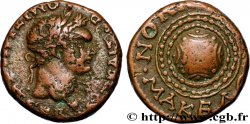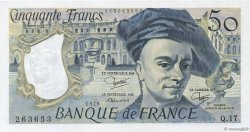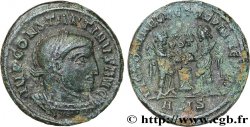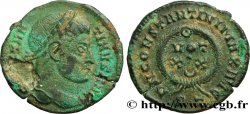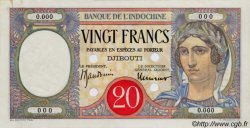v27_0523 - DOMITIANUS Denier
MONNAIES 27 (2006)
Startpreis : 350.00 €
Schätzung : 550.00 €
unverkauftes Los
Startpreis : 350.00 €
Schätzung : 550.00 €
unverkauftes Los
Type : Denier
Datum: 79
Name der Münzstätte / Stadt : Roma
Metall : Silber
Der Feingehalt beträgt : 900 ‰
Durchmesser : 19 mm
Stempelstellung : 6 h.
Gewicht : 3,41 g.
Seltenheitsgrad : R1
Kommentare zum Erhaltungszustand:
Bel exemplaire parfaitement centré au droit. Usure régulière. Fine patine grise
N° im Nachschlagewerk :
Vorderseite
Titulatur der Vorderseite CAESAR AVG F DOMITINANVS COS VI.
Beschreibung Vorderseite Tête laurée de Domitien à droite (O*).
Übersetzung der Vorderseite “Cæsar Augusti Filius Domitianus Consul sextum”, (César fils d’auguste Domitien consul pour la sixième fois).
Rückseite
Titulatur der Rückseite PRINCEPS - IVVENTVTIS.
Beschreibung Rückseite Deux mains jointes avec une aigle légionnaire (aquila) posée sur une proue de navire.
Übersetzung der Rückseite “Princeps Iuventutis”, (Prince de la jeunesse).
Kommentare
Ce revers représente une enseigne très particulière qui pourrait avoir un rapport avec des navires d’observation, “Speculatoria navigia”, (César 4, 26), cités aussi par Tite-Live. Il est très proche du denier de Marc Antoine (RCV 1484), où seules les deux mains jointes diffèrent. Ou, plus simplement, il peut être un appel à la loyauté de l’armée pour reconnaitre les nouveaux princes, comme le fera quelques années plus tard Nerva avec un denier présentant exactement le même revers, à la légende “CONCORDIA EXERCITVM” (RCV 3020). Ce type sera repris sous Titus, avec la mention du septième consulat de Domitien césar (cf. RCV. 2673).
This reverse represents a very particular ensign that could be related to observation ships, “Speculatoria navigia”, (Caesar 4, 26), also mentioned by Livy. It is very close to the denarius of Mark Antony (RCV 1484), where only the two joined hands differ. Or, more simply, it could be a call for loyalty from the army to recognize the new princes, as Nerva would do a few years later with a denarius with exactly the same reverse, with the legend “CONCORDIA EXERCITVM” (RCV 3020). This type will be taken up again under Titus, with the mention of the seventh consulate of Domitian Caesar (cf. RCV. 2673)
This reverse represents a very particular ensign that could be related to observation ships, “Speculatoria navigia”, (Caesar 4, 26), also mentioned by Livy. It is very close to the denarius of Mark Antony (RCV 1484), where only the two joined hands differ. Or, more simply, it could be a call for loyalty from the army to recognize the new princes, as Nerva would do a few years later with a denarius with exactly the same reverse, with the legend “CONCORDIA EXERCITVM” (RCV 3020). This type will be taken up again under Titus, with the mention of the seventh consulate of Domitian Caesar (cf. RCV. 2673)








 Berichten über einen Fehler
Berichten über einen Fehler Die Seite drucken
Die Seite drucken Teilen meiner Auswahl
Teilen meiner Auswahl Stellen Sie eine Frage
Stellen Sie eine Frage Einlieferung/Verkauf
Einlieferung/Verkauf
 Details
Details
